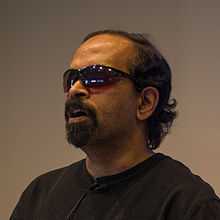T. V. Raman
| TV Raman | |
|---|---|
 | |
| Born |
May 4, 1965 Pune, India[1] |
| Occupation | Computer Scientist, Accessibility researcher |
| Awards | ACM Doctoral Dissertation Award, 1994[2] |
| Website | |
| http://emacspeak.sourceforge.net/raman/ | |
T. V. Raman (born May 4, 1965) is a computer scientist who specializes in accessibility research.[3] His research interests are primarily in the areas of auditory user interfaces and structured electronic documents. He has worked on speech interaction and markup technologies in the context of the World Wide Web at Digital's Cambridge Research Lab (CRL), Adobe Systems and IBM Research.[4] He currently works at Google Research.[4][5] Raman has himself been partially sighted since birth, and blind since the age of 14.[1][3]
He grew up in Pune, India.[6][7]
Raman became blind at the age of 14 due to glaucoma,[4][8][9] being previously partially sighted[6] and able to see with his left eye.[10] To deal with his blindness he had his brother, his mentors, and his aide read out textbooks and problems to him. Although unable to see, he was able to solve Rubik's Cube with a braille version,[4][11][12][13] write computer programs, and perform mathematics.[10][14][15]
Raman attended the University of Pune with a BA in mathematics, IIT Bombay with a MSc in computer science, and Cornell University earning a MS in computer science and a PhD in applied mathematics. His PhD thesis entitled "Audio System For Technical Readings (AsTeR)"[16] was awarded the ACM Doctoral Dissertation Award in 1994.[2] Recently Raman has incorporated these features in the Chrome browser.[17] Raman went on to apply the ideas on audio formatting introduced in AsTeR to the more general domain of computer interfaces Emacspeak. On April 12, 1999, Emacspeak became part of the Smithsonian's Permanent Research Collection on Information Technology at the Smithsonian's National Museum of American History. In 2005 he began work at Google.[4]
Work
- AsTeR – Audio System For Technical Readings
- Aural CSS – producing rich auditory presentations from Web content
- Emacspeak – the complete audio desktop
- XForms – Next Generation Web Forms
- XML Events – A reusable eventing syntax for XML
- XHTML+Voice – Enabling the multimodal Web via voice interaction
- RDC – Reusable Dialog Components
- AxsJAX – Access Enabling AJAX
- Google Accessible Search – for finding accessible Web content
- Thinking Of Mathematics – Thinking Of Mathematics—An Essay on Eyes-Free Computing
- Eyes-Free – Speech enabled Google Android applications.
- ChromeVox – Screen reader from Google Chrome and Google Chrome OS
References
- ↑ 1.0 1.1 Raman, T. V. "Abstract". Audio System for Technical Reading. emacspeak.sourceforge.net. Retrieved 20 June 2012.
- ↑ 2.0 2.1 ACM citation: T. V. Raman. Association for Computing Machinery. 1994.
- ↑ 3.0 3.1 Gibbs, W.W. (1996) Profile: T. V. Raman – Envisioning Speech, Scientific American 275(3), 52-54.
- ↑ 4.0 4.1 4.2 4.3 4.4 Helft, Miguel (January 3, 2009). "For the Blind, Technology Does What a Guide Dog Can’t". New York Times. Retrieved 2009-01-05.
- ↑ "Stevey's Blog Rants: Dynamic Languages Strike Back". yegge.blogspot.com. May 11, 2008. Retrieved 2012-08-31.
- ↑ 6.0 6.1 "PCD Seminar 10/28/94 T.V. Raman". Stanford University. Retrieved 2007-11-07.
- ↑ Raman, T. V (1994). "Audio System for Technical Readings (Ph.D Thesis)". Cornell University. Retrieved 2012-12-28.
- ↑ Guynn, Jessica (July 19, 2006). "Google for the Blind". The San Francisco Chronicle. Retrieved 2007-11-14.
- ↑ Raman, T. V. "DO-IT Mentor Profile". University of Washington. Retrieved 2007-11-14.
- ↑ 10.0 10.1 T. V. Raman (May 25, 2007). "Thinking Of Mathematics—An Essay On Eyes-free Computing". emacspeak.sourceforge.net. Retrieved 2007-11-07.
- ↑ Herzog, Brad (April 26, 2010). "Second Sight". Cornell Alumni Magazine. Cornell University. Retrieved 2010-04-30.
- ↑ Krishnamoorthy, Mukkai (February 14, 2007). "Solving a Braille Rubik's cube". YouTube. Retrieved 2007-11-07.
- ↑ "Watch Blind Man Solve Rubik's Cube". Sky News. Retrieved 2008-10-31.
- ↑ Osgood, Charles (1999-02-11). "Commentary: Computer Software for the Blind". The Osgood File. CBS. Retrieved 2007-11-07. (personal archive copy)
- ↑ Raman, T. V. (May 19, 2007). "An Essay On Eyes-Free Computing". Retrieved 2007-11-07.
- ↑ "Audio System For Technical Readings (AsTeR)"]. Cornell University PhD Thesis.
- ↑ "T.V. Raman’s Audio Deja Vu: From Google, a Math-Reading System for the web"